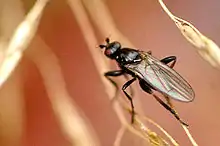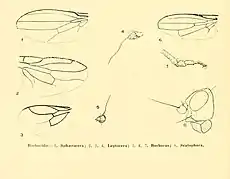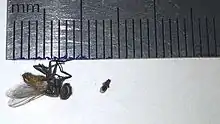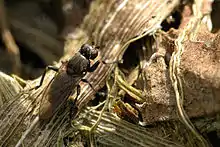Sphaeroceridae
Sphaeroceridae are a family of true flies in the order Diptera, often called small dung flies, lesser dung flies or lesser corpse flies due to their saprophagous habits. They belong to the typical fly suborder Brachycera as can be seen by their short antennae, and more precisely they are members of the section Schizophora. There are over 1,300 species and about 125 genera accepted as valid today, but new taxa are still being described.[2]
| Sphaeroceridae | |
|---|---|
 | |
| Copromyza equina (Copromyzinae) | |
| Scientific classification | |
| Kingdom: | Animalia |
| Phylum: | Arthropoda |
| Class: | Insecta |
| Order: | Diptera |
| Superfamily: | Sphaeroceroidea |
| Family: | Sphaeroceridae Macquart, 1835[1] |
| Subfamilies | |
| Synonyms[2] | |
|
List
| |
Unlike the large "corpse flies" or blow-flies of the family Calliphoridae and the large dung flies of the family Scathophagidae, the small dung flies are members of the schizophoran subsection Acalyptratae. Among their superfamily Sphaeroceroidea, they seem to be particularly close relatives of the family Heleomyzidae.[2]

Description and ecology

For terms see Morphology of Diptera
Dung flies are small to minute, usually dull-colored flies with characteristically thickened first tarsomere of the posterior leg. The first tarsal segment is less than 1+1/2 times as long as the second tarsal segment and dilated. The crossvein separating the second basal and discal cells is missing. Veins four and five often fade apically. They occur all over the world except in regions with permanent ice-cover. Despite their ubiquity and abundance, little is known about their economic or ecological impact. Some species are known to be parthenogenetic.
Larval stages are poorly known, but those described are slender, narrowed anteriorly, with groups of ventral spicules on creeping welts. The larva is amphipneustic (having only the anterior and posterior pairs of spiracles). The mandibles are simple, hooked, and without additional teeth. The parastomal bars are long, thin structures, fused to the tentoropharyngeal sclerite. The hypopharyngeal sclerites are long separate or connected by a sclerotized bridge; the anterior spiracle (prothoracic spiracle) is a rosette or branched. The posterior spiracles (on the anal segment) are usually on two cylindrical lobes. Each spiracle has three slit or oval openings and three or five groups of interspiracular hairs that are branched in some species.
The larvae are microbial grazers found in abundance in many microenvironments with decomposing organic material. Most species appear to be associated with decaying plants or fungi and they are a part of the nutrient cycle. Some species, especially cave species, are polysaprophagous. Many species are associated with various kinds of faeces including human faeces; there are a few carrion-feeding species. These, however, are extremely abundant and are important components of the carrion-insect community. Sphaerocerids that abound in economically important decomposer communities such as compost and manure, and some decay cycles such as the wrack (seaweed) cycle are mediated by sphaerocerid-dominated insect communities.
As their microbe-associated habits suggest, sphaerocerids may carry many pathogenic microorganisms.[3] Although their reclusive habits preclude a major role in disease transmission; some can present a public health hazard on occasion or act as a warning of one. For instance Leptocera caenosa and other sphaerocerids are associated with blocked sewage drains.[4] Some species occasionally reach high population levels in food-processing plants and other buildings where they may indicate blocked drains, waste accumulation and inadequate hygiene. One species, Poecilosomella angulata, has been implicated in human intestinal myiasis[5] They have been implicated as the major means by which nematodes are disseminated among mushroom houses. Sphaeoceridae often coexist with muscoids especially Fannia canicularis and Musca domestica in the complex manure ecosystem of poultry houses, and other confined-animal facilities. Here the sphaeocerids are prey for mites and beetles, which themselves also feed on the immatures of muscoid flies reducing the population of the more problematic muscoids.[6] Carrion-feeding species are useful post mortem interval indicators in forensic entomology.
Genera
The genera are arranged alphabetically according to subfamily; these are arranged in the presumed phylogenetic sequence from the most ancestral to the most advanced:[2]
Subfamily Tucminae Marshall, 1996[7]
Subfamily Copromyzinae Stenhammar, 1855[9]
- Achaetothorax Hedicke, 1923[10]
- Alloborborus Duda, 1923[11]
- Antrops Enderlein, 1909[12]
- Archiborborus Duda, 1921[13]
- Borborillus Duda, 1923[11]
- Copromyza Fallén, 1810
- Crumomyia Macquart, 1835[1]
- Dudaia Hedicke, 1923[10]
- Frutillaria Richards, 1961[14]
- Gymnometopina Hedicke, 1923[10]
- Lotophila Lioy, 1864[15]
- Immoderatus Papp, 2004[16]
- Metaborborus Vanschuytbroeck, 1948[17]
- Norrbomia Papp, 1988[18][19]
- Palaeoceroptera Duda, 1929[20]
- Palaeolimosina Duda, 1920[21]
- Penola Richards, 1941[22]
- Pycnopota Bezzi, 1927[23]
- Richardsia Papp, 1973[24]
Subfamily Sphaerocerinae Macquart, 1835[1]
- Afromyia Kim, 1968[25]
- Ischiolepta Lioy, 1864[15]
- Lotobia Lioy, 1864[15]
- Mesosphaerocera Kim, 1972[26]
- Neosphaerocera Kim, 1972[26]
- Parasphaerocera Spuler, 1924[27]
- Safaria Richards, 1950[28]
- Sphaerocera Latreille, 1804[29]
- Trichosphaerocera Papp, 1978[30]
Subfamily Homalomitrinae Roháček & Marshall, 1998[31]
- Homalomitra Borgmeier, 1931[32]
- Sphaeromitra Roháček & Marshall, 1998[31]

Subfamily Limosininae Frey, 1921[33]
- Acuminiseta Duda, 1925[34]
- Afropterogramma Papp, 2008[35]
- Aluligera Richards, 1951[36]
- Anatalanta Eaton, 1875[37]
- Anomioptera Schiner, 1868[38]
- Anommonia Schmitz, 1917[39]
- Apterobiroina Papp, 1979[40]
- Apteromyia Vimmer, 1929[41]
- Aptilotella Duda, 1924[42]
- Aptilotus Mik, 1898[43]
- Archiceroptera Papp, 1977[44]
- Archicollinella Duda, 1925[34]
- Archileptocera Duda, 1920[21]
- Archipterogrammoides Papp, 2008[35]
- Aspinilimosina Papp, 2004[45]
- Australimosina Papp, 2008[35]
- Bentrovata Richards, 1973[46]
- Biconnecta Papp, 2008[35]
- Biroina Richards, 1973[46]
- Bitheca Marshall, 1987[47]
- Bromeloecia Spuler, 1924[48]
- Cephalimosina Papp, 2008[35]
- Ceroptera Macquart, 1835[1]
- Ceropterella Richards, 1953[49]
- Chaetopodella Duda, 1920[21]
- Chaetosifemur Papp, 2008[35]
- Chespiritos Marshall, 2000[50]
- Coproica Róndani, 1861
- Druciatus Marshall, 1995[51]
- Elachisoma Róndani, 1880
- Eulimosina Roháček, 1983[52]
- Eximilimosina Papp, 2008[35]
- Gigalimosina Roháček, 1983[52]
- Giraffimyiella Papp, 2008[35]
- Gobersa de Coninck, 1983[53]
- Gonioneura Róndani, 1880
- Gonitella Papp, 2008[35]
- Gyretria Enderlein, 1938[54]
- Hellerella Duda, 1920[21]
- Herniosina Roháček, 1983[52]
- Howickia Richards, 1951[36]
- Indiosina Papp, 1981[55]
- Kabaria Richards, 1966[56]
- Lepidosina Marshall & Buck, 2007[57]
- Leptocera Olivier, 1813
- Limomyza Marshall, 1997[58]
- Limosina Macquart, 1835[1]
- Limosinella Richards, 1968[59]
- Lobeliomyia Richards, 1951[36]
- Mesaptilotus Richards, 1951[36]
- Minialula Papp, 2008[35]
- Minilimosina Roháček, 1983[52]
- Mixolimosina Papp, 2008[35]
- Monorbiseta Papp, 2008[35]
- Monteithiana Richards, 1973[46]
- Myrmolimosina Marshall, 2000[60]
- Nearcticorpus Roháček & Marshall, 1982[61]
- Ocellipsis Richards, 1938[62]
- Ocellusia Séguy, 1955[63]
- Opacifrons Duda, 1918[64]
- Opalimosina Roháček, 1983[52]
- Oribatomyia Richards, 1960[65]
- Pachytarsella Richards, 1963[66]
- Palaeocoprina Duda, 1920[21]
- Papualimosina Hayashi, 2006[67]
- Papuella Richards, 1973[46]
- Papuellicesa Koçak & Kemal, 2010[68]
- Paracuminiseta Papp, 2008[35]
- Paralimosina Papp, 1973[24]
- Paramera Papp, 2008[35]
- Paraminilimosina Papp, 2008[35]
- Parapoecilosomella Papp, 2008[35]
- Parapterogramma Papp, 2008[35]
- Paraptilotus Richards, 1938[62]
- Parasclerocoelus Marshall & Dong, 2008[69]
- Paraspelobia Duda, 1938[70]
- Pellucialula Papp, 2004[45]
- Philocoprella Richards, 1929[71]
- Phthitia Enderlein, 1938[54]
- Piliterga Papp, 2008[35]
- Pismira Richards, 1960[65]
- Pleuroseta Richards, 1973[46]
- Poecilosomella Duda, 1925[34]
- Popondetta Richards, 1973[46]
- Pseudacuminiseta Papp, 2008[35]
- Pseudaspinilimosina Papp, 2008[35]
- Pseudocollinella Duda, 1924[72]
- Pseudopterogramma Papp, 2008[35]
- Pteremis Róndani, 1856
- Pterogramma Spuler, 1923[48]
- Pterogrammoides Papp, 1972[73]
- Pullimosina Roháček, 1983[52]
- Puncticorpus Duda, 1918[64]
- Rachispoda Lioy, 1864[15]
- Reunionia Papp, 1979[40]
- Robustagramma Marshall & Cui, 2005[74]
- Rohacekia Papp, 2008[35]
- Rudolfina Roháček, 1987[75]
- Sclerocoelus Marshall, 1995[51]
- Scutelliseta Richards, 1960[76]
- Setositibiella Papp, 2008[35]
- Siphlopteryx Enderlein, 1908[77]
- Spelobia Spuler, 1924[48]
- Spinilimosina Roháček, 1983[52]
- Telomerina Roháček, 1983[52]
- Terrilimosina Roháček, 1983[52]
- Thailimosina Papp, 2008[35]
- Thoracochaeta Duda, 1918[64]
- Trachyopella Duda, 1918[64]
- Trilobitella Papp, 2008[35]
- Trisetomyia Richards, 1965[78]
- Xenolimosina Roháček, 1983[52]
Footnotes
- Macquart1835, P. J. M. Histoire Naturelle des insectes. Dipteres. Tome deuxieme. Paris: Roret. pp. 710, 12 pl.
- Rohček, Jindřich; Marshall, Stephen A.; Norrbom, Allen L.; Buck, Matthias; Quiros, Dora Isabel; Smith, Ian (2001). Rohček, Jindřich (ed.). World Catalog of Sphaeroceridae (Diptera). Opava: Slezské Zemské Muzeum. pp. 1–414. ISBN 978-8086224213. Retrieved 3 September 2017.
- Greenberg, B., 1971. Flies and Disease, volume I: Ecology, Classification,and Biotic Association. Princeton University Press, Princeton, New Jersey.
- Fredeen, F. J. H.; Taylor, M. E. (1964). "Borborids (Diptera: Sphaeroceridae) infesting sewage disposal tanks, with notes on the life cycle, behavior and control of Leptocera(Leptocera) caenosa (Róndani)". Can. Ent. 96 (5): 801–808. doi:10.4039/ent96801-5.
- McKibben, J.W.; Micks, D.W. (1956). "Report of a case of human intestinal myiasis caused by Leptocera venalicia". American Journal of Tropical Medicine and Hygiene. 5 (5): 929–32. doi:10.4269/ajtmh.1956.5.929. PMID 13362764.
- Axtell, R. C. (1985). Chapter 16: "Poultry Pests". In: Livestock Entomology (Williams et al., editors), Wiley & Sons, New York. pp. 269–293.
- Marshall, S. A. (1996). "Tucma fritzi, a new species in the enigmatic genus Tucma Mourguès-Schurter (Diptera, Sphaeroceridae, Tucminae new subfamily)". Studia Dipterologica (3): 283–288.
- Mourguès-Schurter, L. (1987). "Tucma, novo gènero de Copromyzinae para a AmÈrica do Sul (Diptera, Sphaeroceridae)". Revista Brasileira de Entomologia, S"o Paulo. 31 (1): 118–122.
- Stenhammar, C. (1855). "Skandinaviens Copromyzine granskade och beskrifne". Kongliga Vetenskaps-Akademiens Handlingar. Ser. 3. Stockholm. 1853: 257–442.
- Hedicke, H. (1923). "Nomina nova. IV". Deutsche entomologische Zeitschrift. 1923 (4): 431. doi:10.1002/mmnd.48019230413.
- Duda, Oswald (1923). "Revision der altweltlichen Arten der Gattung Borborus (Cypsela) Meigen (Dipteren)". Archiv für Naturgeschichte. Abteilung A. 89 (4): 35–112. Retrieved 3 September 2017.
- Enderlein, Günther (1909). "Antrops truncipennis, eine neue Borboridengattung von Feuerland". Zoologischer Anzeiger. 34: 225–230. Retrieved 4 September 2017.
- Duda, Oswald (1921). "Fiebrigella und Archiborborus, zwei neue südamerikanische Borboriden-gattungen (Dipteren)". Tijdschrift voor Entomologie. 64: 119–146. Retrieved 4 September 2017.
- Richards, O. W. (1961). "Diptera (Sphaeroceridae) from south Chile". Proceedings of the Royal Entomological Society of London B. 30: 57–68.
- Lioy, P. (1864). I Ditteri distribuiti secondo un nuovo metodo di classifi cazione naturale Serie III, 9. Venezia: Atti dellíIstituto Veneto di Scienze, Lettere ed Arti. pp. 1087–1126.
- Papp, L. (2004). "Immoderatus gen. n. of Copromyzinae (Diptera: Sphaeroceridae)" (PDF). Acta Zoologica Academiae Scientiarum Hungaricae. 50 (1): 45–53. Retrieved 2 September 2017.
- Vanschuytbroeck, P. (1948). "Sphaeroceridae (Diptera, Acalyptratae)". Exploration du Parc National Albert, Mission G. F. De Witte (1933-35). 52: 1–43.
- Papp, L. (1988). "A review of the Afrotropical species of Norrbomia gen.n. (Diptera: Sphaeroceridae, Copromyzini)". Acta Zoologica Hungarica. 34: 393–408.
- Marshall, Stephen A.; Norrbom, Allen L. (1992). "A revision of the New World species of Norrbomia (Diptera: Sphaeroceridae), including all American species previously placed in Borborillus". Insecta Mundi. Center for Systematic Entomology, Gainesville, Florida. 6 (3–4): 151–181. Retrieved 3 September 2017.
- Duda, Oswald (1929). "Die Ausbeute der deutschen Chako-Expedition 1925/1926 (Diptera). VI. Sepsidae, VII. Piophilidae, VIII. Cypselidae, IX. Drosophilidae und X. Chloropidae". Konowia. 8 (1): 33–50.
- Duda, Oswald (1920). "Vorläufige Mitteilung zur Kenntnis der außereuropäischen Arten der Gattungen Leptoceras Olivier=Limosina Macq. und Borborus Meigen (Dipteren)". Zoologische Jahrbücher. Zeitschrift für Systematik, Geographie und Biologie der Tier. 43: 433–446. Retrieved 17 September 2017.
- Richards, O. W. (1941). "Sphaeroceridae (Diptera) collected by the British Graham Land Expedition, 1934-1937". British Graham Land Expedition 1934-37, Scientific Reports. 1 (7): 323–326.
- Bezzi, Mario (1927). "A new genus and species of Borborid flies from South America". Proceedings of the United States National Museum. 68 (2621): 1–6. doi:10.5479/si.00963801.68-2621.1. Retrieved 17 September 2017.
- Papp, László (1973). "Sphaeroceridae (Diptera) from Mongolia". Acta Zoologica Academiae Scientiarum Hungaricae. 19: 369–425.
- Kim, K. C. (1968). "Revision of Sphaerocera, with description of a new genus Afromyia (Diptera: Sphaeroceridae)". Annals of the Entomological Society of America. 61 (2): 296–312. doi:10.1093/aesa/61.2.296.
- Kim, K. C. "The New World genus Parasphaerocera and allied groups, with descriptions of new genera and species (Diptera: Sphaeroceridae)". Miscellaneous Publications of the Entomological Society of America. 8 (6): 377–444.
- Spuler, Anthony (1924). "North American species of the genus Sphaerocera and Aptilotus (Diptera, Borboridae)". The Pan-Pacific Entomologist. San Francisco: The Pacific Coast Entomological Society. 1: 66–71. Retrieved 17 September 2017.
- Richards, O. W. (1950). "New species of Sphaeroceridae (Diptera) found with driver ants (Dorylinae) by S. Patrizi and F. Meneghetti". Bollettino dellí Istituto di Entomologia della Università degli Studi di Bologna. 18: 14–23.
- Latreille, Pierre André (1805). Histoire naturelle, générale et particulière des crustacés et des insectes. 14. Paris: Dufart. pp. 1–432. Retrieved 17 September 2017.
- Papp, László (1978). "Sphaeroceridae (Diptera) in the collection of the Hungarian Natural History Museum. IV. Sphaerocerinae". Acta Zoologica Academiae Scientiarum Hungaricae. 24: 371–395.
- Roháček, J.; Marshall, S. A. (1998). "Revision of Homalomitrinae subfam.n. (Diptera:Sphaeroceridae), with the description of a new genus and three new species" (PDF). European Journal of Entomology. 95 (3): 455–491. Retrieved 12 October 2017.
- Borgmeier, T. (1931). "Um cypselideviso ecitophilo de Goyaz (Dipt., Cypselidae)". Reta de Entomologia, São Paulo. 1 (1): 30–37.
- Frey, R. (1921). "Studien über der Bau des Mundes der niederen Diptera Schizophora nebst Bemerkungen über die Systematik dieser Dipteren-Gruppe". Acta Societatis Pro Fauna et Flora Fennica. Helsinki. 48 (3): 1–247. Retrieved 21 October 2017.
- Duda, Oswald (1925). "Die außereuropäischen Arten der Gattung Leptocera Olivier - Limosina Macquart (Dipteren) mit Berücksichtigung der europäischen Arten" (PDF). Archiv für Naturgeschichte. Abteilung A. Berlin. 90 ((11)(1924): 5–21. Retrieved 21 October 2017.
- Papp, László (2008). "New genera of the Old World Limosininae (Diptera, Sphaeroceridae)" (PDF). Acta Zoologica Academiae Scientiarum Hungaricae. 54(supplement 2): 47–209. Retrieved 24 October 2017.
- Richards, O. W. (1951). "Brachypterous Sphaeroceridae". British Museum (Natural History) Ruwenzori Expedition, 1934-1935. 2 (8): 829–851.
- Eaton, A. E. (1875). "Breves dipterarum uniusque lepidopterarum insulae Kerguelensi indigenarum diagnoses". The Entomologist's Monthly Magazine. 12: 58–61.
- Schiner, J. R. (1868). Diptera. In: Reise der österreichischen Fregatte Novara um die Erde in den Jahren 1857, 1858, 1859 unter den Befehlen des Commodore B. von Wüllerstorf-Urbair. Zoologischer Theil. 2. Wien: B. K. Gerold’s Sohn. pp. Pt. 1, vi + 388 pp.
- Schmitz, H. (1917). "Anommonia, eine neue myrmecophile Borboridengattung aus Kamerun". Zoologische Mededelingen. Leiden. 3: 121–126.
- Papp, László. "On apterous and reduced-winged forms of the family Drosophilidae, Ephydridae and Sphaeroceridae (Diptera)" (PDF). Acta Zoologica Academiae Scientiarum Hungaricae. 25: 357–374. Retrieved 22 October 2017.
- Vimmer, A. (1929). "Dvě nové bezkřídlé mouchy (čel. Cypselidae) [Zwei neue fluegellosen Di- pteren - Fam. Cypselidae]". Časopis Československé Společnosti Entomologické. 26: 64–68.
- Duda, Oswald. "Aptilotella Borgmeieri ♂, eine neue flügellose Borboride (Dipt.) aus Brasilien" (PDF). Natuurhistorisch Maandblad, Maastricht. 13 (5): 74–76. Retrieved 22 October 2017.
- Mik, Josef (1898). "Altes und neues über Dipteren". Wiener Entomologische Zeitung. 17: 196–219. doi:10.5962/bhl.part.3129. Retrieved 22 October 2017.
- Papp, László. "A contribution to the knowledge of species of the subfamily Ceropterinae (Diptera: Sphaeroceridae)" (PDF). Acta Zoologica Academiae Scientiarum Hungaricae. 23 (2): 371–385. Retrieved 22 October 2017.
- Papp, László (2004). "Two new genera of the Oriental Sphaeroceridae (Diptera)" (PDF). Annales Historico-Naturales Musei Nationalis Hungarici. 96: 103–114. Retrieved 24 October 2017.
- Richards, O. W. (1973). "The Sphaeroceridae (= Borboridae or Cypselidae; Diptera Cyclorrhapha) of the Australian Region". Australian Journal of Zoology, Supplementary Series. 21 (22): 297–401. doi:10.1071/ajzs022.
- Marshall, S. A. (1987). "Systematics of Bitheca, a new genus of New World Sphaeroceridae (Diptera)". Systematic Entomology. 12 (3): 355–380. doi:10.1111/j.1365-3113.1987.tb00207.x. ISSN 0307-6970.
- Spuler, Anthony (1924). "North American genera and subgenera of the dipterous family Borboridae". Proceedings of the Academy of Natural Sciences of Philadelphia. 75 (1923): 369–378.
- Richards, O. W. (1953). "Two new African species of Ceroptera Meigen (Diptera, Sphaeroceridae)". Proceedings of the Royal Entomological Society of London B. 22: 5–8.
- Marshall, S. A. (2000). "Chespiritos, a new genus of Limosininae (Diptera: Sphaeroceridae) from Costa Rica". Proceedings of the Entomological Society of Washington. 102: 609–612. Retrieved 22 October 2017.
- Marshall, S. A . (1995). "Sclerocoelus and Druciatus, new genera of New World Sphaeroceridae (Diptera; Sphaeroceridae; Limosininae)". Insecta Mundi. University of Nebraska - Lincoln. 9: 283–289. Retrieved 22 October 2017.
- Roháček, Jindřich (1983). "A monograph and re-classification of the previous genus Limosina Macquart (Diptera, Sphaeroceridae) of Europe. Part II". Beiträge zur Entomologie, Berlin. 33: 3–195. Retrieved 23 October 2017.
- Coninck, E. de (1983). "Gobersa leleupi n.g., n.sp., a brachypterous Sphaerocerid from the Uluguru Mountains, Tanzania (Diptera)". Revue de Zoologie Africaine, Tervuren. 97 (2): 337–344.
- Enderlein, Günther (1938). Skottsberg, C. (ed.). "60. Die Dipterenfauna der Juan-Fernandez-Inseln und der Oster-Insel". The Natural History of Juan Fernández and Easter Island (Zool.) Uppsala. 3: 643–680.
- Papp, László (1981). "Two new genera of the apterous and subapterous Sphaeroceridae (Diptera) from India". Acta Zoologica Academiae Scientiarum Hungaricae. 27: 381–388.
- Richards, O. W. (1966). "New Sphaeroceridae (Diptera) from the Kivu district, with a revision of the genus Aluligera Richards". Revue de Zoologie et de Botanique Africaines. 73: 201–254.
- Marshall, S. A.; Buck, M.; Lonsdale, O. (2007). "Lepidosina, a new genus of New World Limosininae (Diptera: Sphaeroceridae)" (PDF). European Journal of Entomology. 104 (3): 573–599. doi:10.14411/eje.2007.074. Retrieved 24 October 2017.
- Marshall, S. A. (1997). "Limomyza, a new genus of primitive Limosininae (Diptera: Sphaeroceridae), with five new species from United States, Mexico and Central America". Proceedings of the Entomological Society of Washington. 99: 279–289. Retrieved 23 October 2017.
- Richards, O. W. (1968). "Some Sphaeroceridae (Diptera), partly short-winged, collected in South Africa by Monsieur N. Leleup" (PDF). Annals of the Natal Museum, Pietermaritzburg. 20: 93–108. Retrieved 23 October 2017.
- Marshall, S. A. (2000). "A new genus of ant-like sphaerocerid from Mexico (Diptera, Sphaeroceridae)". Studia dipterologica. 7: 213–223.
- Roháček, Jindřich; Marshall, S. A. "A monograph of the genera Puncticorpus Duda, 1918 and Nearcticorpus gen.n. (Diptera, Sphaeroceridae)". Zoologische Jahrbücher, Abteilung für Systematik, Ökologie und Geographie der Tiere. 109: 357–398.
- Richards, O. W. (1938a). "Diptera Sphaeroceridae (Borboridae, Cypselidae). Mission scientifique de l'Omo". Mémoires du Museum National d'Histoire Naturelle. Paris. 4 (40): 381–405.
- Séguy, Eugène (1955). "Deux Cypsélides aptères de Madagascar (Diptères)" (PDF). Naturaliste Malgache. 7: 77–81. Retrieved 23 October 2017.
- Duda, Oswald (1918). "Revision der europäischen Arten der Gattung Limosina Macquart (Dipteren)". Abhandlungen der k.k. Zoologisch-botanischen Gesellschaft in Wien. 10 (1): 1–240.
- Richards, O. W. (1960). "Further brachypterous and apterous Sphaeroceridae in the collection of the Musée royal du Congo belge". Revue de Zoologie et de Botanique Africaines. 61: 320–332.
- Richards, O. W. (1963). "Diptera: Sphaeroceridae (Borboridae)". Insects of Micronesia. 14 (5): 109–134.
- Hayashi, T. (2006). "Description of a new genus Papualimosina (Diptera, Sphaeroceridae) from the Australasian Region". Japanese Journal of Systematic Entomology. 12: 225–229.
- Koçak, A. Ö; Kemal, M. (2010). "Nomenclatural notes on the genus group names of the order Diptera". Miscellaneous Papers, Centre for Entomological Studies Ankara. 151: 5–7.
- Marshall, Stephen A.; Dong, H. (2008). "Parasclerocoelus, a new south temperate genus of Limosininae (Diptera: Sphaeroceridae)". Studia Dipterologica. 15: 223–230.
- Duda, Oswald (1938). Lindner, E. (ed.). "Sphaeroceridae (Cypselidae)". Die Fliegen der Paläarktischen Region. Stuttgart: E. Schweizerbartísche Verlagsbuchhandlung. 6 (57): 1–182.
- Richards, O. W. (1929). "Systematic notes on the Borboridae (Diptera) with description of new species of Leptocera (Limosina)". The Entomologist's Monthly Magazine. 65: 171–176.
- Duda, O. (1924). "Berichtigungen zur Revision der europäischen Arten der Gattung Limosina Macq. (Dipteren), nebst Beschreibung von sechs neuen Arten" (PDF). Verhandlungen der Zoologisch-botanischen Gesellschaft in Wien. 73 (1923): 163–180. Retrieved 23 October 2017.
- Papp, László (1972). "New genera and species of Sphaeroceridae (Diptera) from New Guinea". Acta Zoologica Academiae Scientiarum Hungaricae. 18: 101–115.
- Marshall, Stephen A.; Cui, Yongsheng (2005). "Systematics of Robustagramma, a new genus of New World Sphaeroceridae (Diptera)". Zootaxa. Auckland, New Zealand: Magnolia Press. 1026: 1–122. doi:10.11646/zootaxa.1026.1.1. ISSN 1175-5334.
- Roháček, Jindřich (1987a). "Replacement name for Rudolfia Roháček, 1982 (Diptera, Sphaeroceridae), with first record of R. rozkosnyi from northern Europe". Acta Entomologica Bohemoslovaca. 84: 474–476.
- Richards, O. W. (1960). "A genus and species of wingless fly from South Africa (Diptera, Sphaeroceridae)" (PDF). Annals of the Natal Museum. 15: 71–73. Retrieved 23 October 2017.
- Enderlein, Günther (1908). Drygalski, E. D. von (ed.). Die Insekten des antarktischen Gebietes. In Deutsch Südpolar-Expedition 1901-1903 im Auftrage des Reichsamtes des Innern heraus- gegeben von Erich von Drygalski, Leiter der Expedition. X. Zoologie. 2. Berlin: G. Reimer. pp. 361–528.
- Richards, O. W. (1965). "Diptera, Flightless Sphaeroceridae and Chloropidae. Mission zoologique de l'I.R.S.A.C. en Afrique orientale. (P. Basilewsky et N. Leleup, 1957)". Annales du Musée Royal de l'Afrique Central, Tervuren, Série in 8 o , Sciences Zoologiques. 138: 415–464.
References
- Roháček, Jindřich (ed.) (2001): World Catalogue of Sphaeroceridae. Slezské zemské muzeum, Opava, Czech Republic. ISBN 80-86224-21-X PDF fulltext without images
- K. G. V. Smith, 1989 An introduction to the immature stages of British Flies. Diptera Larvae, with notes on eggs, puparia and pupae.Handbooks for the Identification of British Insects Vol 10 Part 14. pdf download manual (two parts Main text and figures index)
Further reading
- Oswald Duda,1938. 57. Sphaeroceridae (Cypselidae). In Lindner, E. (ed.): Die Fliegen der Paläarktischen Region Vol.6, 182 pp., E. Schweizerbart.sche Verlagsbuchhandlung, Stuttgart.
- Scientific papers by Theodor Becker
- Hackman, W (1965). "On the genus Copromyza Fall. (Dipt., Sphaeroceridae), with special reference to the Finnish species". Notul. Ent. 45: 33–46.
- Pitkin, B.R. (1988). Lesser dung flies. Diptera: Sphaeroceridae. Handbooks for the Identification of British Insects 10(5e). London: Royal Entomological Society. ISBN 0-901546-67-4
- Richards, O.W. (1930). "The British species of Sphaeroceridae (Borboridae:Diptera)". Proceedings of the Zoological Society of London. 18: 261–345.
- Rohácek, J. (1982-5). A monograph and reclassification of the previous genus Limosina Macquart (Diptera, Sphaeroceridae) of Europe, parts 1 to 4. Beitrage zur Entomologie
- Eugene Seguy. 1934. Cypselidae. Faune de France volume 28, pp. 444–473. virtuelle numérique
External links
| Wikimedia Commons has media related to Sphaeroceridae. |
- Family description and images
- Page on Sphaeroceridae in houses
- Image Gallery from Dipter.info
- Picture of Leptocera limosa, a typical sphaerocerid
- Wing venation
Species lists